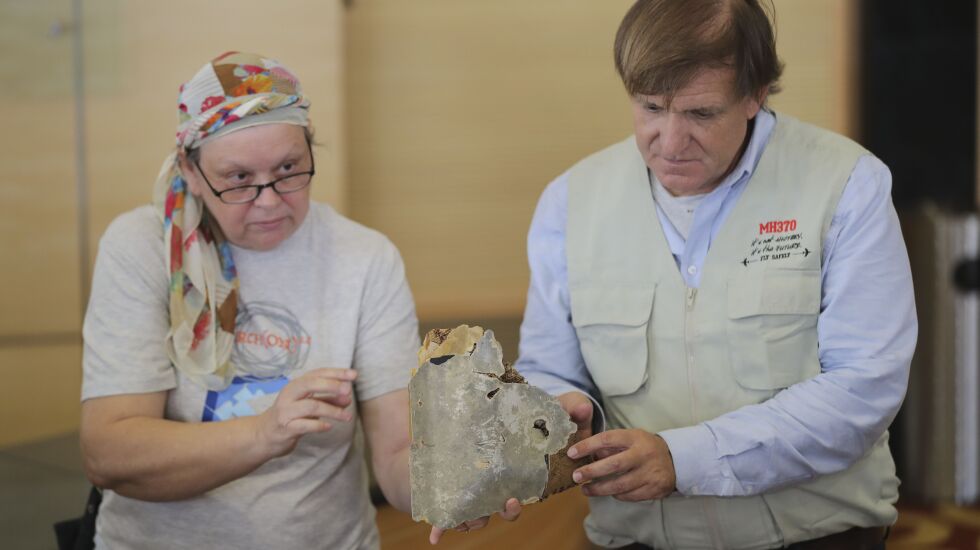
Somebody out there somewhere knows what happened to Malaysian Airlines Flight 370.
Or maybe her secrets are buried forever, lost along with the 239 passengers who were onboard that flight in 2014 — a flight whose whereabouts remain a mystery and are the foundation for some wild and yet not entirely dismissable conspiracy theories.
Was it a hijacking? A case of mass murder/suicide by pilot? A terrible accident? A meteorite? An act of warfare?
These are some of the theories explored in the three-part Netflix documentary series “MH370: The Plane That Disappeared,” a compelling and fact-driven work that occasionally veers into tabloid, unmonitored chat-room level territory when it gives voice to a handful of folks whose theories are dubious at best. On balance, though, director Louise Malkinson and executive producers Sam Maynard and Fiona Stourton do a solid job of laying out the known details with the help of archival news footage, a few obligatory dramatic re-creations and some immensely helpful graphics, while retaining a healthy skepticism about some of the more outlandish hypotheses put forth over the last nine years.
Is the mystery solved? As producer Harry Hewland says in the press materials, “We knew from the start that if thousands of technically savvy aviation experts hadn’t found an answer, what hope did a bunch of TV producers have?” Where “MH370” succeeds is in laying out the case for three key theories and leaving it to the viewer to determine which is the most plausible.
Each episode focuses on one primary theory while also exploring a few other possibilities, as we hear from aviation experts, journalists, airline officials and surviving family members, whose grief has been compounded over by the incompetence and arrogance of the Malaysian government, and the lack of closure.
Here’s what we know for sure: At 12:14 a.m., Flight 370 takes off from Kuala Lumpur International Airport on a redeye to Beijing Capital International Airport. When the plane is about to leave Malaysian air space and communications will be handed off to the control tower in Vietnam, Captain Zaharie Ahmad Shah says to the tower, “Uh, good night Malaysian 370” in a matter-of-fact tone. About 90 seconds later, the plane goes electronically dark, vanishes from the radar and is never heard from again.
- Episode One, titled “The Pilot,” explores the theory that Zaharie Ahmad Shah deliberately crashed the plane into the Indian Ocean. Says aviation journalist Jeff Wise, “Maybe he says to the co-pilot, ‘Hey buddy, why don’t you go back and get me something,’ ” after which the pilot would lock the door and turn off all the electronics. “Maybe he starts depressurizing the cabin…” Maybe. Maybe. But why? No plausible explanation is ever given, no proof is ever produced.
- Episode Two, “The Hijack,” looks into the possibility a small group of Russian passengers gained access to the electronics bay, switched off equipment and somehow gained control of the plane, which eventually wound up in Kazakhstan. Says aviation expert Mike Exner: “It’s all based on fantasies, not reality.”
- In Episode Three, “The Intercept,” a French journalist advances the hypothesis there was suspicious and problematic cargo aboard the plane, and the U.S. military had no choice but to take out the plane to stop that sensitive cargo from reaching China, either by missile strike or mid-air collision.
I know. It all sounds crazy. And to the credit of the filmmakers, they’re for the most part as skeptical as we are. Throughout the series, we keep seeing news reports about the latest shocking twist or dramatic turn in the ongoing investigation. At one point it seems all but certain that contrary to the original flight path that would have seen the plane crashing in the South China Sea, radar data indicates it took a hard left and wound up in the Indian Ocean. Enter one “Blaine Gibson, Adventurer,” as the graphics identify him, a globe-trotting character who tells us he was on a Facebook group and asked oceanographers where he might find debris from the wreckage. “And they said, ‘There will be debris on the Mozambique channel on the coast of Mozambique.’ … So I went to Vilanculos, a town on the Mozambique channel, and I asked people if they had seen any debris.”

Boom! The next thing we see is footage of Gibson in sandals, khakis and a T-shirt, finding small pieces of debris within 20 minutes of his arrival. Well THAT was easy. Meanwhile, there’s a woman in Florida who tells us, “My hobby is photography, so I have an eye for detail…” and is convinced she has found images of the wreckage in the original search site of the South China Sea.
So many of the theories we see explored in “MH370: The Plane That Disappeared” are outlandish, not fully formed, difficult to believe. And yet, and yet … a plane carrying some 239 souls took off from Malaysia in the middle of the night some nine years ago, and as if we’re in some real-life nightmare straight out of “The Twilight Zone,” we know something bizarre and tragic occurred.







